The Domeless Solar Telescope (DST)
|
The Sun is the only star for which we can observe fine details on
its surface and investigate the associated activity. Once the underlying
physics has been established, it can be applied to the understanding
of other activities in the Universe.
The Domeless Solar Telescope
(DST) was designed to acquire solar surface images at the highest
spatial resolution. Since its establishment in
1979, the DST has contributed to the great scientific progress in recent years in the
understanding of the mechanisms which cause solar explosive events, and other phenomena in
space plasma physics.
|
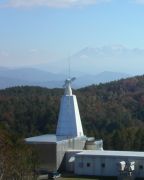
View of the DST
|
|
The DST Lyot filter has a very narrow passband of 0.25
angstroms, and provides arbitrary wavelength tuning. With
this filter, we can see the three-dimensional velocity structure of
the solar atomosphere.
|
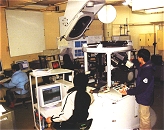
The observing room.
|
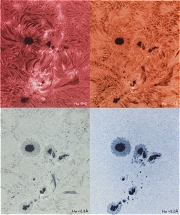
The 3D structure of the solar surface seen using the H alpha Lyot filter and DST.
|
|
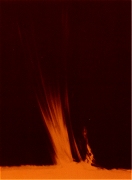
An eruptive prominence. At the time of the image, the prominence
has reached a height of 250,000 km, and has a velocity of 300 km/s.
|
|
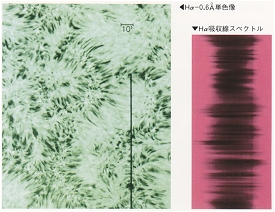
The chromospheric network spectrum and spicules around the H
alpha line.
|
|
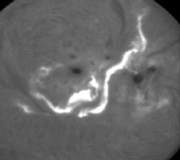
A typical example of a two-ribbon flare. It is characterized by
two ribbon-shaped brighetenings separating from each other. [ Click for the movie]
|
|
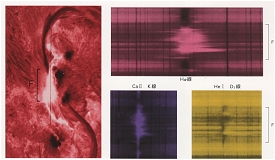
A high-resolution spectrum of a flare (denoted by "F" in the
left panel) in H alpha, Ca K, and He D3 lines.
Broadening and redenning of the bright Ha line is evidence of downward
gas motion at 100 km/s.
|
|
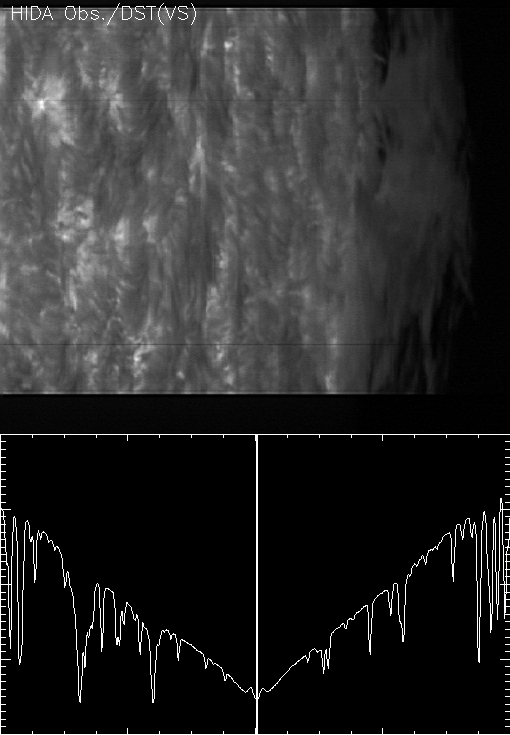
Recently, we have performed cooperative observations with HINODE-satellite by using the spectroheliograph on the Vertical Spectroscope especially around Ca II K and H lines.
|
|
| Operating the DST |
|
The file sizes are somewhat large, so it may take some time to download them.
- Automatic guide to make the telescope point toward
the Sun. [QuickTime (4.5MB)], [GIF animation (4.9MB)]
- To open the entrance lid and let in the Sun's light. [QuickTime (7.2 MB)], [GIF animation (7.4MB)]
- At the start of daily operations, the observer searches
for an object suitable for the scientific purpose of his research, such as a prominence, some emerging flux, spots, etc.
When the object comes
into the field of view, the observer can look at its 3D structure by changing
the observed wavelength.
[QuickTime(14 MB)], [GIF Animation(32 MB)]
|
|
The performance
|
|
|
| Type | Domeless Tower Vacuum Telescope |
| Optical type | Gregorian type reflector telescope |
| Effective apature | 600 mm |
| Focal length of objective mirror | 3,150mm |
| Total focal length | 32.19m |
| Total F ratio | F/53.7 |
| Resolution | 0.18 arcsec at 500 nm |
| The diameter of the solar image | 299.95 mm = 1922 arcsec
(1arcsec = 0.1561 mm) |
| Tracking system | Photoelectric sensor |
| Pressure inside the vacuum chamber | 2 - 5 mmHg |
| Mount type | Altazimuth mount |
| Total weight | 21 ton |
|
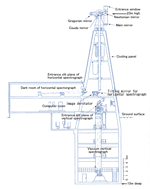
The overall structure of the DST
|
| Horizontal | Vertical |
| Optics Type | Czerny-Turner type | Vacuumed Czerny-Turner type |
| Focal length | 10m | 14m |
| Dispersion | 0.33 A/mm (2nd order) | 0.14 A/mm (5th order) |
| Effective wavelength range | 3600 - 15000 A | 3600 - 15000 A |
| Total weight | 3 ton | 10 ton |
| Note | Simultaneous observation
of all the visible spectrum can be done. | High dispersion and high resolution |
|

